tire pressure TOYOTA AVALON 2017 XX40 / 4.G Quick Reference Guide
[x] Cancel search | Manufacturer: TOYOTA, Model Year: 2017, Model line: AVALON, Model: TOYOTA AVALON 2017 XX40 / 4.GPages: 52, PDF Size: 2.72 MB
Page 3 of 52
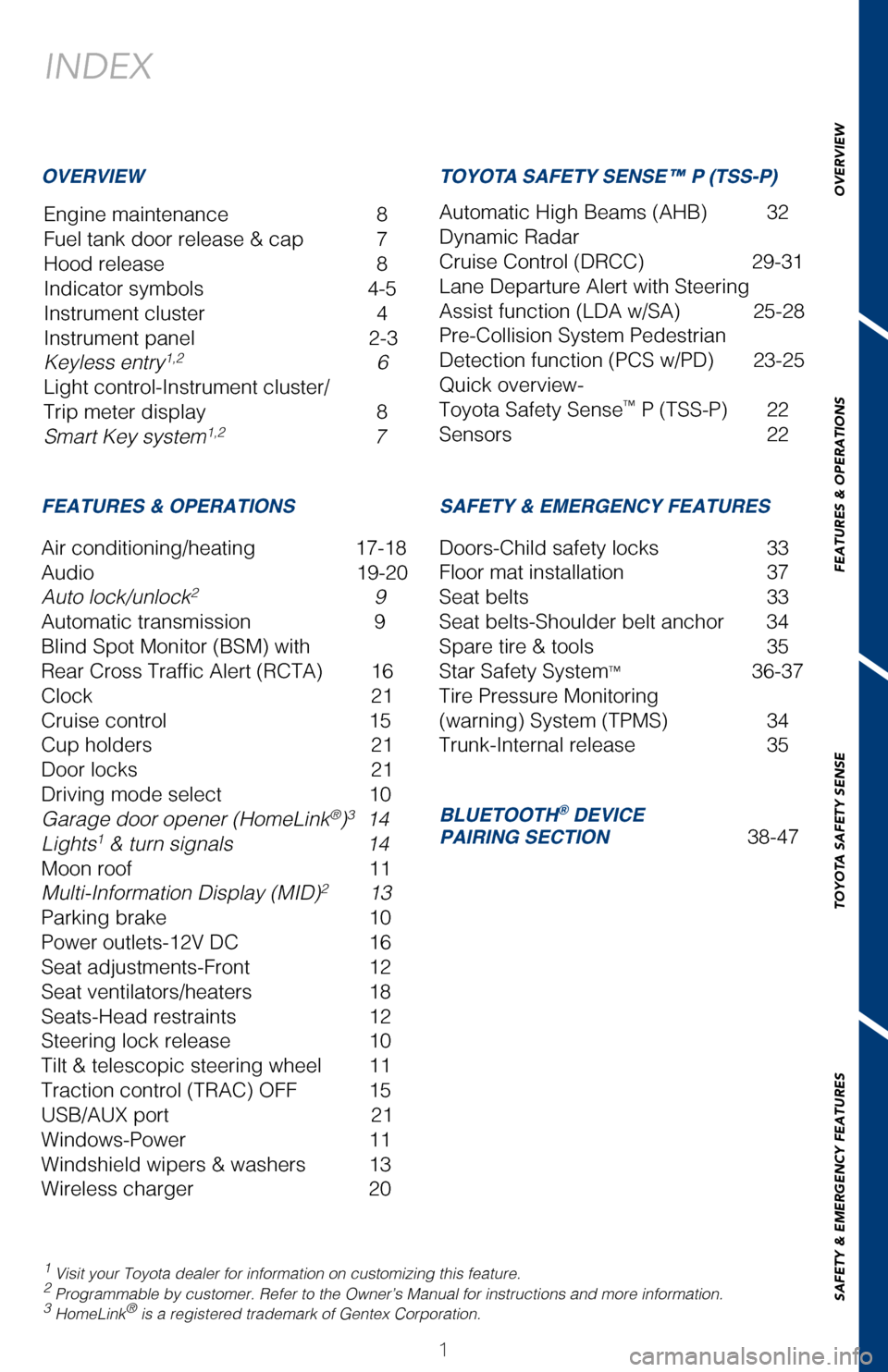
OVERVIEW
FEATURES & OPERATIONS
TOYOTA SAFETY SENSE
SAFETY & EMERGENCY FEATURES
1
INDEX
Engine maintenance 8
Fuel tank door release & cap 7
Hood release 8
Indicator symbols 4-5
Instrument cluster 4
Instrument panel 2-3
Keyless entry
1,2 6
Light control-Instrument cluster/
Trip meter display 8
Smart Key system
1,2 7
1 Visit your Toyota dealer for information on customizing this feature.2 Programmable by customer. Refer to the Owner’s Manual for instructio\
ns and more information.3 HomeLink® is a registered trademark of Gentex Corporation.
OVERVIEW
FEATURES & OPERATIONS SAFETY & EMERGENCY FEATURES
Air conditioning/heating 17-18
Audio 19-20
Auto lock/unlock
2 9
Automatic transmission 9
Blind Spot Monitor (BSM) with
Rear Cross Traffic Alert (RCTA) 16
Clock 21
Cruise control 15
Cup holders 21
Door locks 21
Driving mode select 10
Garage door opener (HomeLink
®)3 14
Lights1 & turn signals 14
Moon roof 11
Multi-Information Display (MID)
2 13
Parking brake 10
Power outlets-12V DC 16
Seat adjustments-Front 12
Seat ventilators/heaters 18
Seats-Head restraints 12
Steering lock release 10
Tilt & telescopic steering wheel 11
Traction control (TRAC) OFF 15
USB/AUX port 21
Windows-Power 11
Windshield wipers & washers 13
Wireless charger 20 Doors-Child safety locks
33
Floor mat installation 37
Seat belts 33
Seat belts-Shoulder belt anchor 34
Spare tire & tools 35
Star Safety System
™ 36-37
Tire Pressure Monitoring
(warning) System (TPMS) 34
Trunk-Internal release 35
AVALON 2017
This Quick Reference Guide is a summary of basic vehicle
operations. It contains brief descriptions of fundamental
operations so you can locate and use the vehicle’s main
equipment quickly and easily.
The Quick Reference Guide is not intended as a substitute for
the Owner’s Manual located in your vehicle’s glove box. We
strongly encourage you to review the Owner’s Manual and
supplementary manuals so you will have a better understanding
of your vehicle’s capabilities and limitations.
Your dealership and the entire staff of Toyota Motor Sales,
U.S.A., Inc. wish you many years of satisfied driving in your new
Avalon.
A word about safe vehicle operations
This Quick Reference Guide is not a full description of Avalon operation\
s.
Every Avalon owner should review the Owner’s Manual that accompanies \
this
vehicle.
Pay special attention to the boxed information highlighted in color throughout
the Owner’s Manual. Each box contains safe operating instructions to \
help you
avoid injury or equipment malfunction.
All information in this Quick Reference Guide is current at the time of \
printing.
Toyota reserves the right to make changes at any time without notice.
BLUETOOTH® DEVICE
PAIRING SECTION 38-47
TOYOTA SAFETY SENSE™ P (TSS-P)
Automatic High Beams (AHB) 32
Dynamic Radar
Cruise Control (DRCC) 29-31
Lane Departure Alert with Steering
Assist function (LDA w/SA) 25-28
Pre-Collision System Pedestrian
Detection function (PCS w/PD) 23-25
Quick overview-
Toyota Safety Sense
™ P (TSS-P) 22
Sensors 22
2017_Avalon_QRG_D4_1-R1.indd 19/26/16 12:32 PM
Page 5 of 52
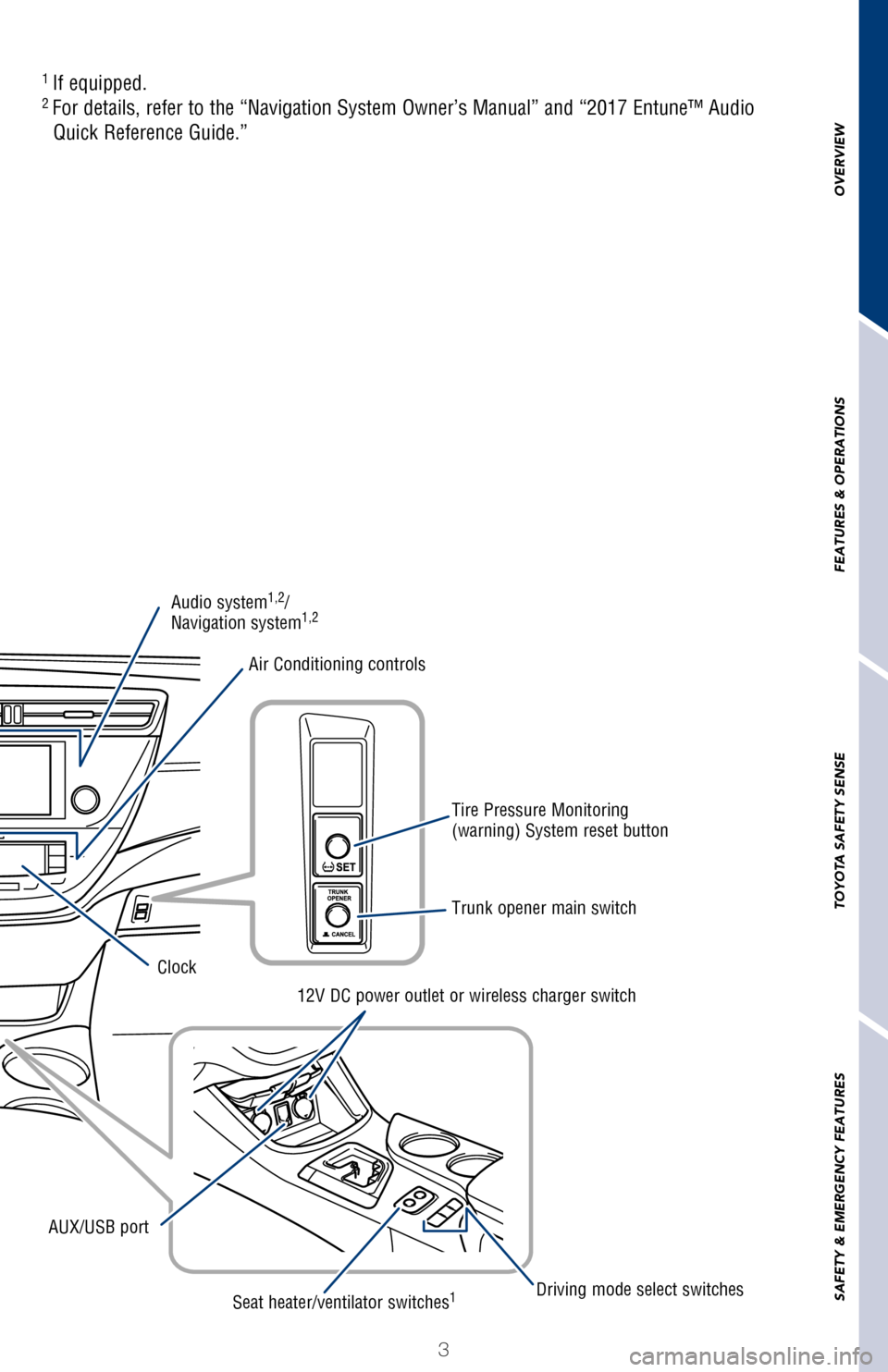
OVERVIEW
FEATURES & OPERATIONS
TOYOTA SAFETY SENSE
SAFETY & EMERGENCY FEATURES
3
Voice command
switch2
DISP switch
Dynamic Radar
Cruise Control (DRCC)
Vehicle-to-vehicle
distance switch
Rear sunshade switch1
Emergency flasher button
Audio system1,2/
Navigation system1,2
Air Conditioning controls
Tire Pressure Monitoring
(warning) System reset button
Trunk opener main switch
12V DC power outlet or wireless charger switch
Driving mode select switches
Seat heater/ventilator switches
1
AUX/USB port Clock
1
If equipped.2 For details, refer to the “Navigation System Owner’s Manual” an\
d “2017 Entune™ Audio
Quick Reference Guide.”
Lane Departure Alert
with Steering Assist
(LDA w/SA) switch
Dynamic Radar Cruise
Control (DRCC)switch or
Cruise control switch
2017_Avalon_QRG_D4_1.indd 39/22/16 7:16 PM
Page 7 of 52
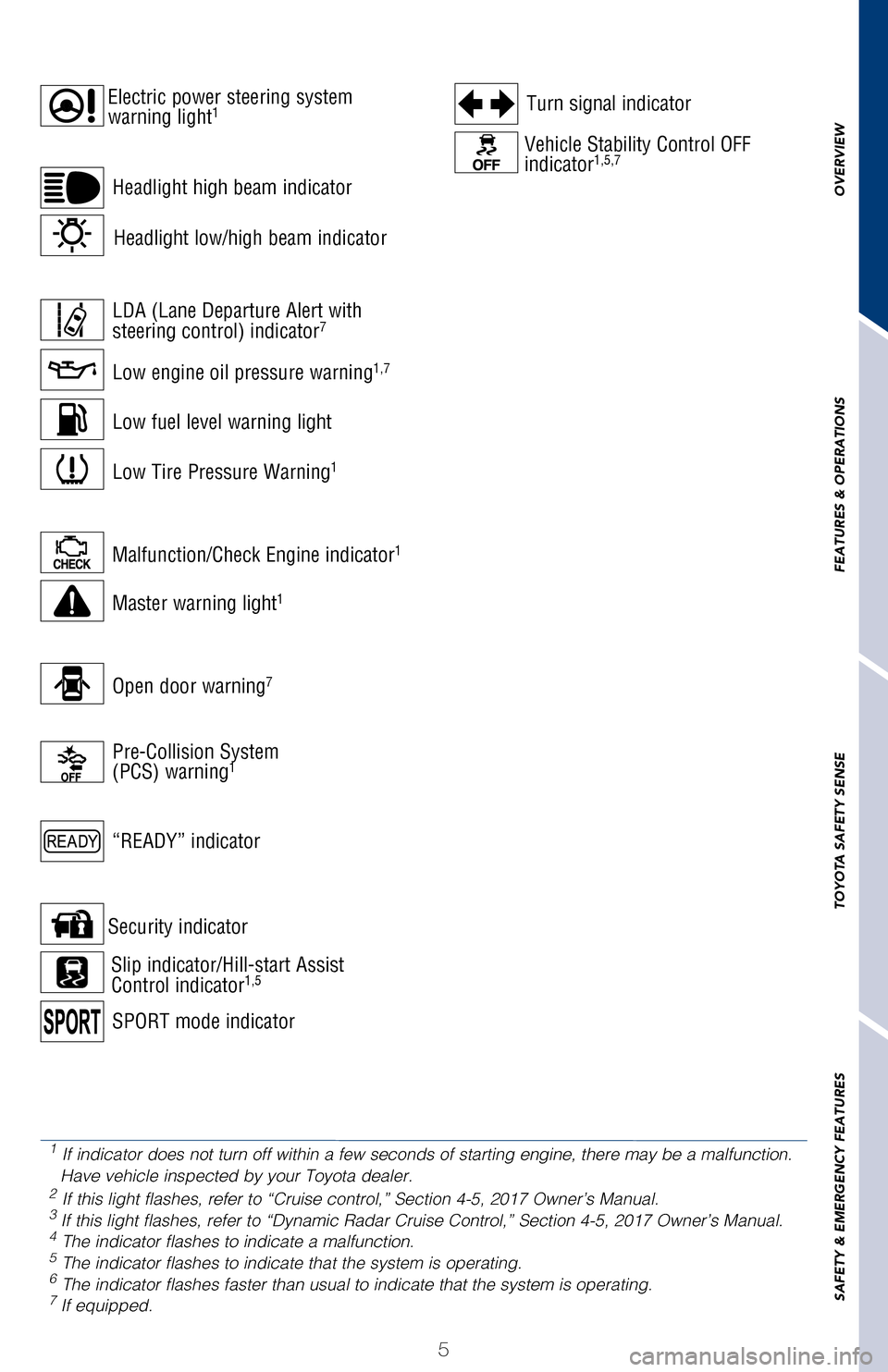
OVERVIEW
FEATURES & OPERATIONS
TOYOTA SAFETY SENSE
SAFETY & EMERGENCY FEATURES
5
For details, refer to “Indicators and warning lights,” Section 2-2\
, 2017 Owner’s
Manual.
Open door warning7
1
If indicator does not turn off within a few seconds of starting engine, \
there may be a malfunction.
Have vehicle inspected by your Toyota dealer.
2 If this light flashes, refer to “Cruise control,” Section 4-5, 201\
7 Owner’s Manual.3 If this light flashes, refer to “Dynamic Radar Cruise Control,” Se\
ction 4-5, 2017 Owner’s Manual.4 The indicator flashes to indicate a malfunction.5 The indicator flashes to indicate that the system is operating.6 The indicator flashes faster than usual to indicate that the system is \
operating.7 If equipped.
Malfunction/Check Engine indicator1
Master warning light1
Electric power steering system
warning light1
Cruise control SET indicator
ECO drive mode indicator
EV drive mode indicator
EV indicator
Headlight low/high beam indicator
Headlight high beam indicator
Low engine oil pressure warning
1,7
Low Tire Pressure Warning1
Low fuel level warning light
LDA (Lane Departure Alert with
steering control) indicator7
Pre-Collision System
(PCS) warning1
“READY” indicator
Turn signal indicator
Vehicle Stability Control OFF
indicator1,5,7
Security indicator
SPORT mode indicator
Slip indicator/Hill-start Assist
Control indicator1,5Dynamic Radar Cruise Control
indicator3,4
Driver seat belt reminder (alarm
sounds for speeds over 12 mph)
Service indicators and reminders
2017_Avalon_QRG_D4_1.indd 59/22/16 7:16 PM
Page 15 of 52
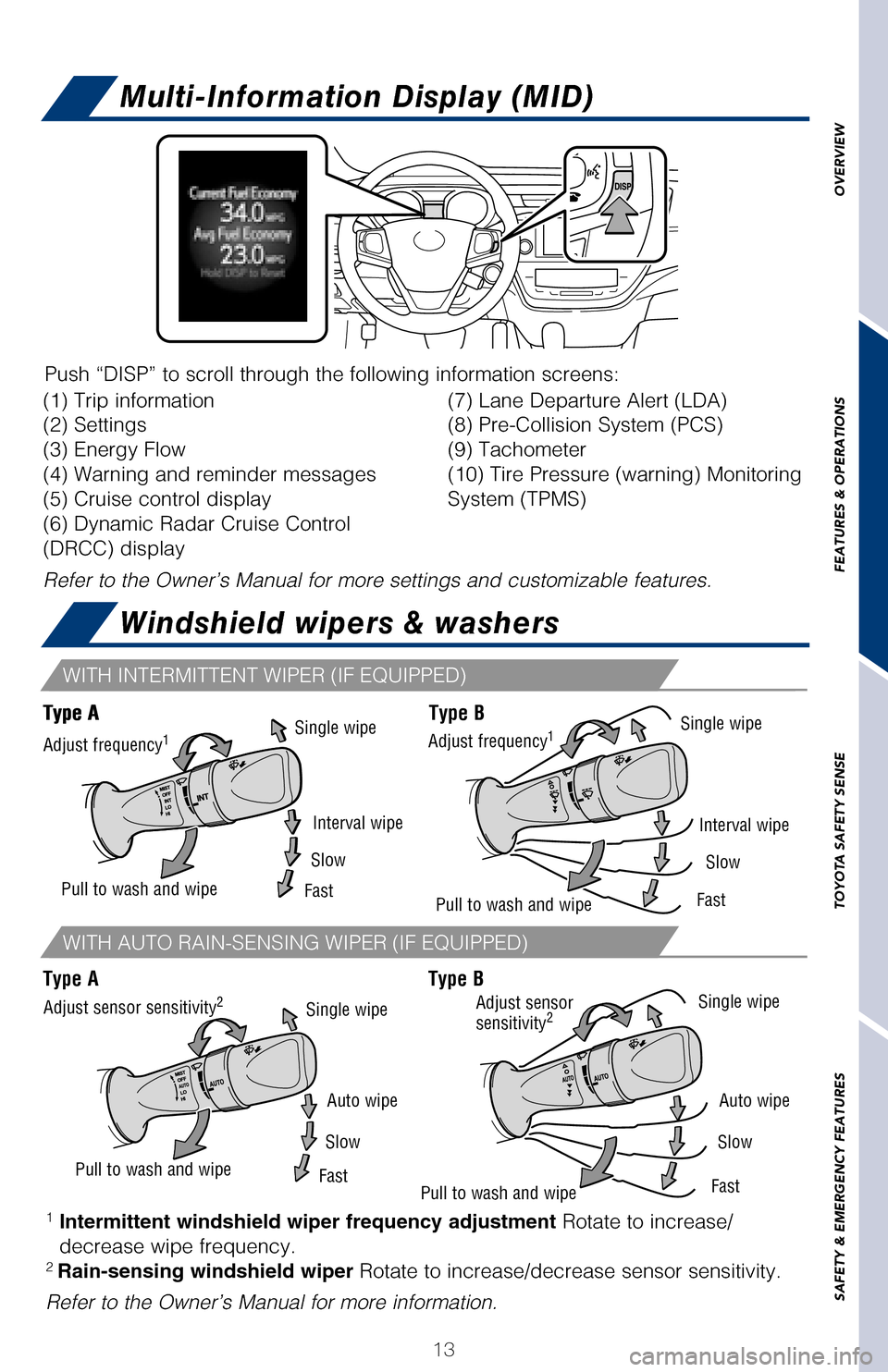
OVERVIEW
FEATURES & OPERATIONS
TOYOTA SAFETY SENSE
SAFETY & EMERGENCY FEATURES
13
Lumbar support (if equipped)
Seatback angle
Multi-Information Display (MID)
Windshield wipers & washers
Push “DISP” to scroll through the following information screens:
Refer to the Owner’s Manual for more settings and customizable featur\
es. (1) Trip information
(2) Settings
(3) Energy Flow
(4) Warning and reminder messages
(5) Cruise control display
(6) Dynamic Radar Cruise Control
(DRCC) display (7) Lane Departure Alert (LDA)
(8) Pre-Collision System (PCS)
(9) Tachometer
(10) Tire Pressure (warning) Monitoring
System (TPMS)
Adjust sensor sensitivity2Adjust sensor
sensitivity2
Pull to wash and wipe
Pull to wash and wipe
Single wipeSingle wipe
Auto wipeAuto wipe
SlowSlow
FastFast
1 Intermittent windshield wiper frequency adjustment Rotate to increase/
decrease wipe frequency.
2 Rain-sensing windshield wiper Rotate to increase/decrease sensor sensitivity.
Refer to the Owner’s Manual for more information.
Pull to wash and wipe Pull to wash and wipe
Single wipeSingle wipeSingle wipe
Interval wipeInterval wipeInterval wipe
SlowSlowSlow
FastFastFast
Adjust frequency
1Adjust frequency1Type A
Type B
Type A
Type A Type B
WITH AUTO RAIN-SENSING WIPER (IF EQUIPPED)
WITH INTERMITTENT WIPER (IF EQUIPPED)
2017_Avalon_QRG_D4_1.indd 139/22/16 7:16 PM
Page 36 of 52
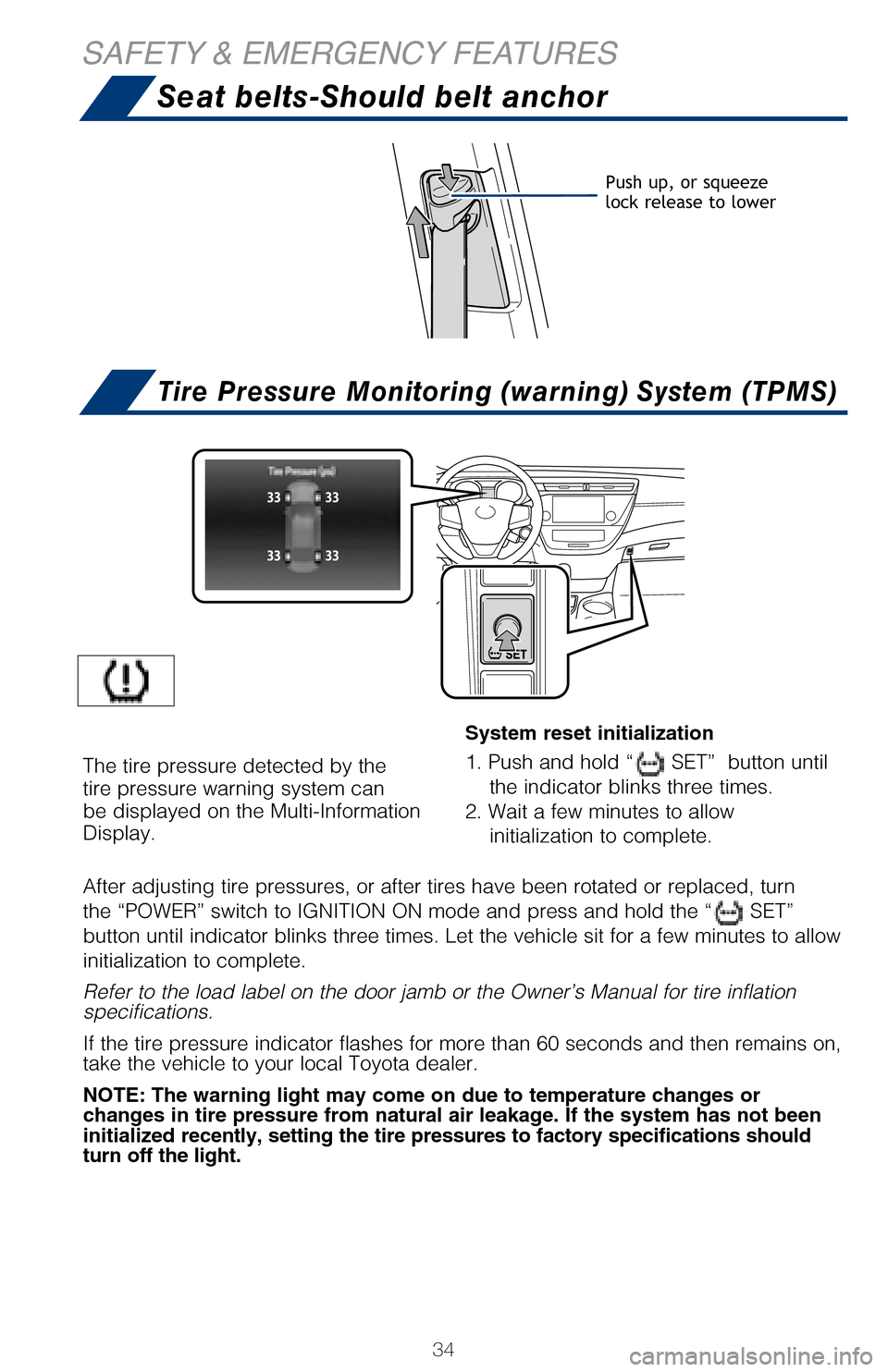
34
Seat belts-Should belt anchor
Tire Pressure Monitoring (warning) System (TPMS)
SAFETY & EMERGENCY FEATURES
Push up, or squeeze
lock release to lower
System reset initialization
1. Push and hold “
SET” button until
the indicator blinks three times.
2. Wait a few minutes to allow initialization to complete.
The tire pressure detected by the
tire pressure warning system can
be displayed on the Multi-Information
Display.
After adjusting tire pressures, or after tires have been rotated or repl\
aced, turn
the “POWER” switch to IGNITION ON mode and press and hold the “
SET”
button until indicator blinks three times. Let the vehicle sit for a few\
minutes to allow
initialization to complete.
Refer to the load label on the door jamb or the Owner’s Manual for ti\
re inflation
specifications.
If the tire pressure indicator flashes for more than 60 seconds and then remains on,
take the vehicle to your local Toyota dealer.
NOTE: The warning light may come on due to temperature changes or
changes in tire pressure from natural air leakage. If the system has not\
been
initialized recently, setting the tire pressures to factory specifications should
turn off the light.
TOOL LOCATION
REMOVE THE SPARE TIRE
Wheel nut wrench
Refer to the Owner’s Manual for tire changing and jack positioning pr\
ocedures.
(1)
2017_Avalon_QRG_D4_1.indd 349/22/16 7:17 PM
Page 37 of 52
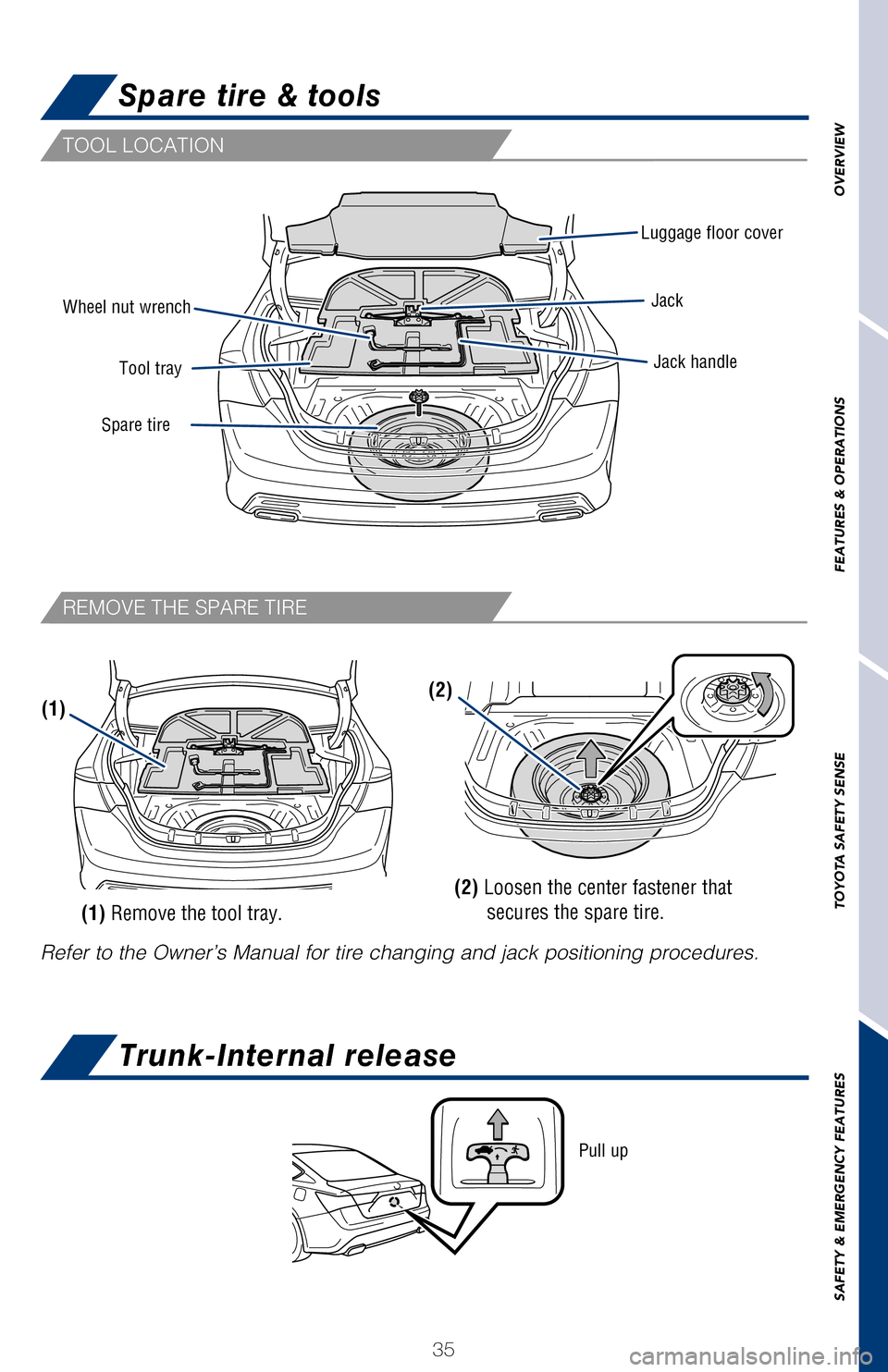
35
OVERVIEW
FEATURES & OPERATIONS
TOYOTA SAFETY SENSE
SAFETY & EMERGENCY FEATURES
Tire Pressure Monitoring (warning) System (TPMS)
System reset initialization
1. Push and hold “
SET” button until
the indicator blinks three times.
2. Wait a few minutes to allow initialization to complete.
After adjusting tire pressures, or after tires have been rotated or repl\
aced, turn
the “POWER” switch to IGNITION ON mode and press and hold the “
SET”
button until indicator blinks three times. Let the vehicle sit for a few\
minutes to allow
initialization to complete.
Refer to the load label on the door jamb or the Owner’s Manual for ti\
re inflation
specifications.
If the tire pressure indicator flashes for more than 60 seconds and then remains on,
take the vehicle to your local Toyota dealer.
NOTE: The warning light may come on due to temperature changes or
changes in tire pressure from natural air leakage. If the system has not\
been
initialized recently, setting the tire pressures to factory specifications should
turn off the light.
Pull up
Spare tire & tools
Trunk-Internal release
TOOL LOCATION
REMOVE THE SPARE TIRE
Luggage floor cover
JackJack handle
Spare tire Tool tray
Wheel nut wrench
Refer to the Owner’s Manual for tire changing and jack positioning pr\
ocedures.
(1)(2)
(2) Loosen the center fastener that secures the spare tire.
(1) Remove the tool tray.
2017_Avalon_QRG_D4_1.indd 359/22/16 7:17 PM
Page 38 of 52
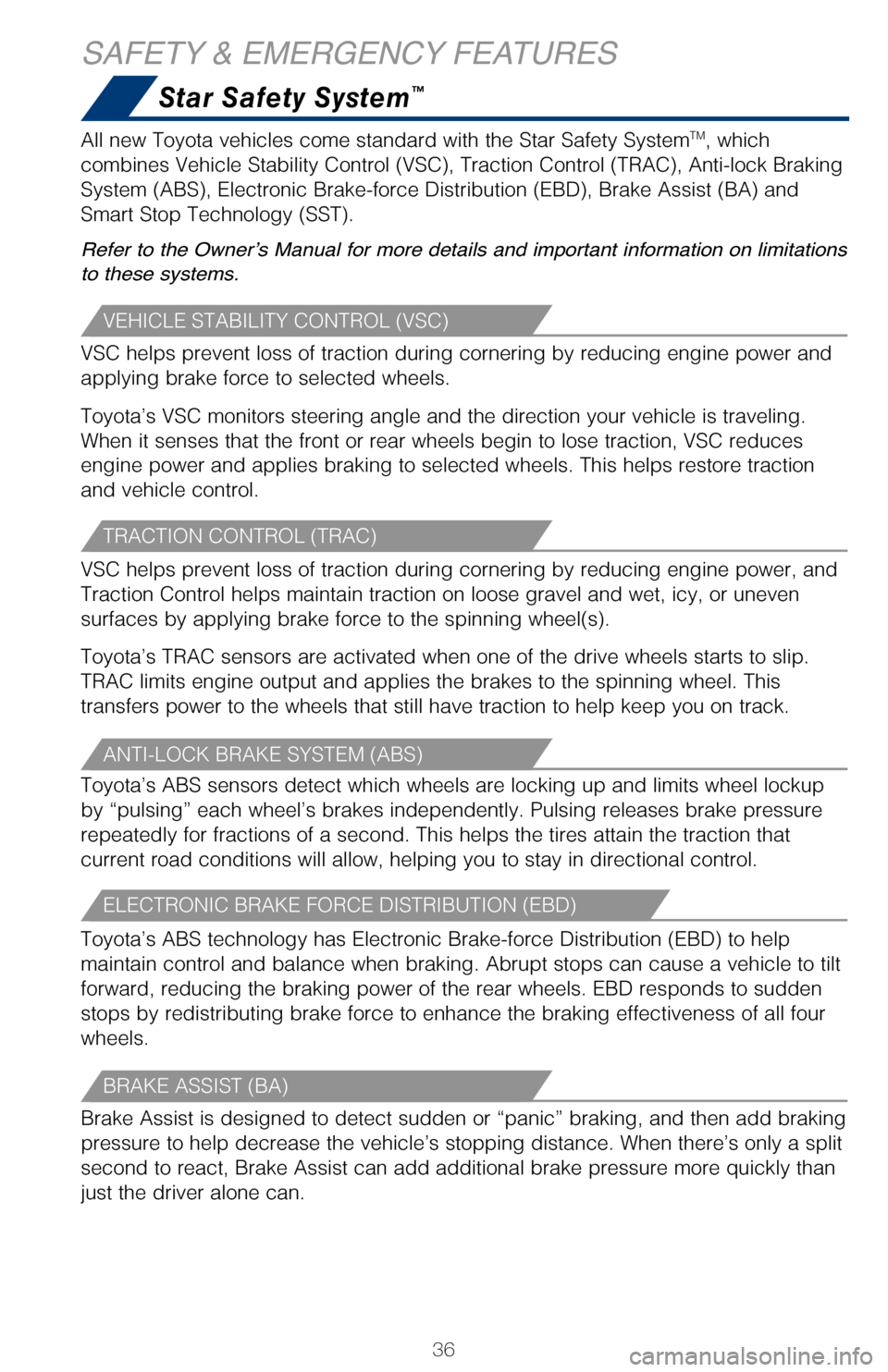
36
SAFETY & EMERGENCY FEATURES
Star Safety System™
VEHICLE STABILITY CONTROL (VSC)
TRACTION CONTROL (TRAC)
ANTI-LOCK BRAKE SYSTEM (ABS)
ELECTRONIC BRAKE FORCE DISTRIBUTION (EBD)
BRAKE ASSIST (BA)
VSC helps prevent loss of traction during cornering by reducing engine p\
ower and
applying brake force to selected wheels.
Toyota’s VSC monitors steering angle and the direction your vehicle i\
s traveling.
When it senses that the front or rear wheels begin to lose traction, VSC\
reduces
engine power and applies braking to selected wheels. This helps restore \
traction
and vehicle control.
Toyota’s ABS sensors detect which wheels are locking up and limits wh\
eel lockup
by “pulsing” each wheel’s brakes independently. Pulsing release\
s brake pressure
repeatedly for fractions of a second. This helps the tires attain the tr\
action that
current road conditions will allow, helping you to stay in directional c\
ontrol.
Brake Assist is designed to detect sudden or “panic” braking, and \
then add braking
pressure to help decrease the vehicle’s stopping distance. When there\
’s only a split
second to react, Brake Assist can add additional brake pressure more qui\
ckly than
just the driver alone can. VSC helps prevent loss of traction during cornering by reducing engine p\
ower, and
Traction Control helps maintain traction on loose gravel and wet, icy, o\
r uneven
surfaces by applying brake force to the spinning wheel(s).
Toyota’s TRAC sensors are activated when one of the drive wheels star\
ts to slip.
TRAC limits engine output and applies the brakes to the spinning wheel. \
This
transfers power to the wheels that still have traction to help keep you \
on track.
Toyota’s ABS technology has Electronic Brake-force Distribution (EBD\
) to help
maintain control and balance when braking. Abrupt stops can cause a vehi\
cle to tilt
forward, reducing the braking power of the rear wheels. EBD responds to \
sudden
stops by redistributing brake force to enhance the braking effectiveness\
of all four
wheels. All new Toyota vehicles come standard with the Star Safety System
TM, which
combines Vehicle Stability Control (VSC), Traction Control (TRAC), A\
nti-lock Braking
System (ABS), Electronic Brake-force Distribution (EBD), Brake Assis\
t (BA) and
Smart Stop Technology (SST).
Refer to the Owner’s Manual for more details and important information on limitations
to these systems.
SMART STOP TECHNOLOGY (SST)
There are two types of Toyota floor mats: carpeted and all-weather. Each\
vehicle
has model-specific floor mats. Installation is easy.
To keep your floor mat properly positioned, follow these steps:
• Only use Toyota floor mats designed for your specific model.
• Use only one floor mat at a time, using the retaining hooks to keep the mat in place.
• Install floor mats right side up. Smart Stop Technology automatically reduces engine power when the accele\
rator
and brake pedals are pressed simultaneously under certain conditions.
SST engages when the accelerator is depressed first and the brakes are a\
pplied
firmly for longer than one-half second at speeds greater than five miles\
per hour.
SST doesn’t engage if the brake pedal is depressed before the acceler\
ator pedal,
allowing vehicles to start on a steep hill and safely accelerate without\
rolling
backward.
2017_Avalon_QRG_D4_1.indd 369/22/16 7:17 PM
Page 39 of 52
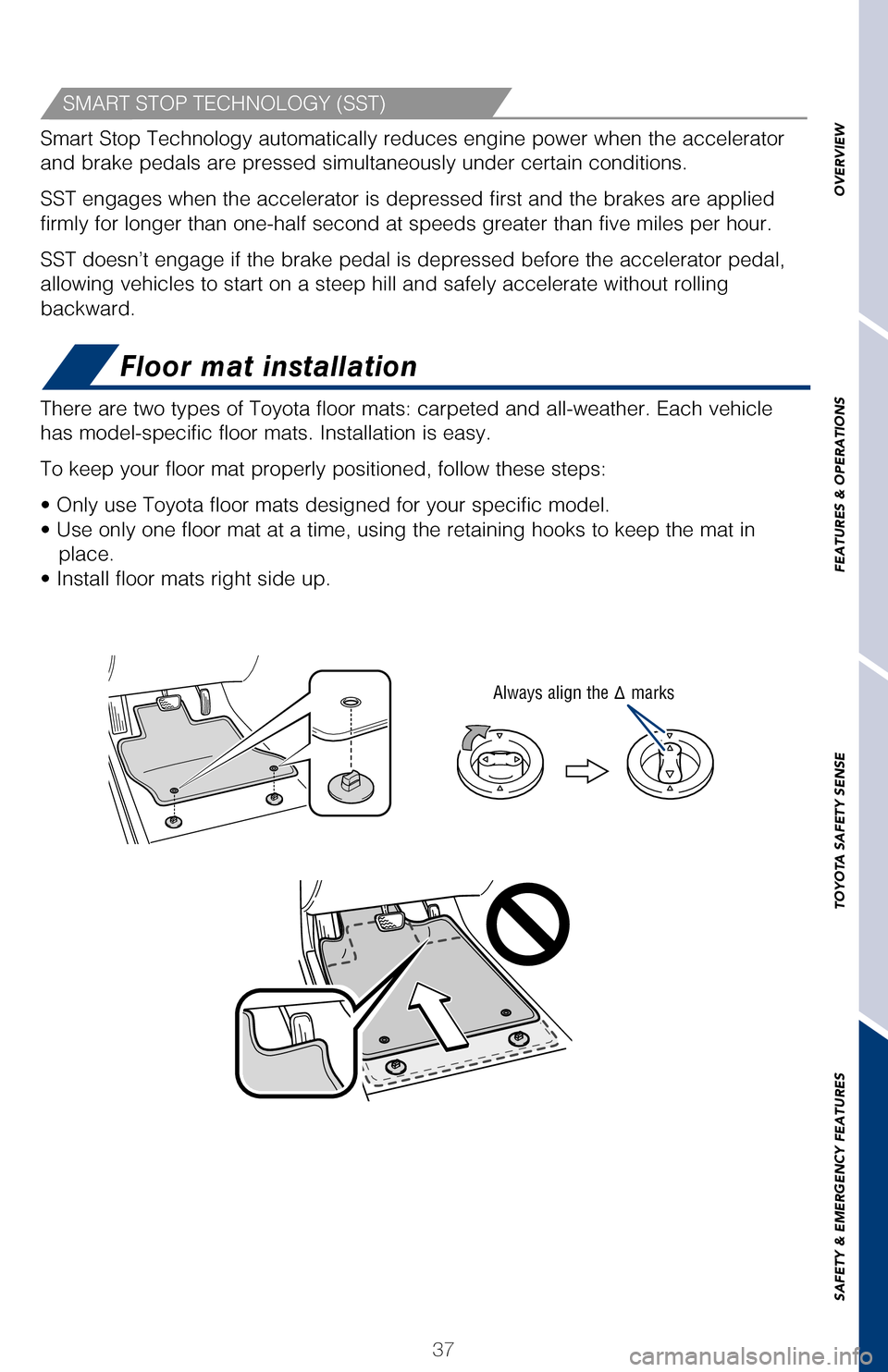
37
OVERVIEW
FEATURES & OPERATIONS
TOYOTA SAFETY SENSE
SAFETY & EMERGENCY FEATURES
Star Safety System™
VSC helps prevent loss of traction during cornering by reducing engine p\
ower and
applying brake force to selected wheels.
Toyota’s VSC monitors steering angle and the direction your vehicle i\
s traveling.
When it senses that the front or rear wheels begin to lose traction, VSC\
reduces
engine power and applies braking to selected wheels. This helps restore \
traction
and vehicle control.
Toyota’s ABS sensors detect which wheels are locking up and limits wh\
eel lockup
by “pulsing” each wheel’s brakes independently. Pulsing release\
s brake pressure
repeatedly for fractions of a second. This helps the tires attain the tr\
action that
current road conditions will allow, helping you to stay in directional c\
ontrol.
Brake Assist is designed to detect sudden or “panic” braking, and \
then add braking
pressure to help decrease the vehicle’s stopping distance. When there\
’s only a split
second to react, Brake Assist can add additional brake pressure more qui\
ckly than
just the driver alone can. VSC helps prevent loss of traction during cornering by reducing engine p\
ower, and
Traction Control helps maintain traction on loose gravel and wet, icy, o\
r uneven
surfaces by applying brake force to the spinning wheel(s).
Toyota’s TRAC sensors are activated when one of the drive wheels star\
ts to slip.
TRAC limits engine output and applies the brakes to the spinning wheel. \
This
transfers power to the wheels that still have traction to help keep you \
on track.
Toyota’s ABS technology has Electronic Brake-force Distribution (EBD\
) to help
maintain control and balance when braking. Abrupt stops can cause a vehi\
cle to tilt
forward, reducing the braking power of the rear wheels. EBD responds to \
sudden
stops by redistributing brake force to enhance the braking effectiveness\
of all four
wheels. All new Toyota vehicles come standard with the Star Safety System
TM, which
combines Vehicle Stability Control (VSC), Traction Control (TRAC), A\
nti-lock Braking
System (ABS), Electronic Brake-force Distribution (EBD), Brake Assis\
t (BA) and
Smart Stop Technology (SST).
Refer to the Owner’s Manual for more details and important information on limitations
to these systems.
Floor mat installation
SMART STOP TECHNOLOGY (SST)
There are two types of Toyota floor mats: carpeted and all-weather. Each\
vehicle
has model-specific floor mats. Installation is easy.
To keep your floor mat properly positioned, follow these steps:
• Only use Toyota floor mats designed for your specific model.
• Use only one floor mat at a time, using the retaining hooks to keep the mat in place.
• Install floor mats right side up. Smart Stop Technology automatically reduces engine power when the accele\
rator
and brake pedals are pressed simultaneously under certain conditions.
SST engages when the accelerator is depressed first and the brakes are a\
pplied
firmly for longer than one-half second at speeds greater than five miles\
per hour.
SST doesn’t engage if the brake pedal is depressed before the acceler\
ator pedal,
allowing vehicles to start on a steep hill and safely accelerate without\
rolling
backward.
Always align the Δ marks
2017_Avalon_QRG_D4_1.indd 379/22/16 7:17 PM